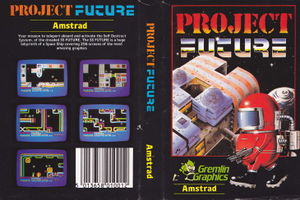Project Future
| |||||||||||||||||||||||||||||||||||||||||||||
Contents
YouTube User Un-Earths Rare Project Future Game
A YouTube user has unearthed what could be a rare piece of history for fans of the Amstrad CPC 464. The unnamed user found a game called Project Future, after finding a CPC 464 in a friend’s attic. He sourced a second hand keyboard that was compatible with the old computer and decided to buy a selection of games to play on it.
Upon testing the games, he came across one called Project Future. The platform game, which was developed for the Amstrad CPC series and the ZX Spectrum, was released in 1985 by Gremlin Graphics of Sheffield. It was originally programmed by Dominic Wood and the graphics were devised by Julian Wood.
The YouTube user that stumbled across this colourful game was impressed by its light-hearted gameplay, sense of fun and vibrant colour schemes. The lack of information about this game on the internet led him to believe that Project Future could indeed be a rare game. This inspired him to record a video of the game during play and to post it to YouTube.
You can view Project Future in action here:
{{#ev:youtube|f2plfQ1wNbQ|400}}
Gameplay
The adventure game consists of 256 screens that are spread over five different decks. Each screen contains what were – at the time – “amazing graphics”, as is printed on the game’s cover sleeve.
The main character, a man that appears to be wearing a space back pack, enters the screen on a mini jet. He is then teleported aboard a spaceship ready to begin his mission. To proceed through each level successfully, the player must combat enemies that constantly appear in his or her path. This can be done through stunning each enemy by firing bullets from a gun. The enemies, after momentarily disappearing, then reappear again. The player must dodge and defeat them to reach each check point and move on to the next level.
Each screen has a network of teleporting points, which allows the player to move around the screen quickly. Throughout the mission, the player must look out for eight hidden “destruct codes”. Once all eight codes are found and picked up, the player will be able to activate a “self destruct system”. Finally, once this has been activated, the gamer must quickly escape the screen. If escape is not made in time, the main character will be destroyed and the game will be over.
Sounds in the game are typical of that era; the game exhibits arcade ‘buzzes’ and ‘beeps’ as the main character progresses through the screens. Basic congratulatory note sequences are played upon completion of a level, as are defeatist jingles when levels are failed or when the player reaches ‘game over’ status.
Retro imagery
Colours are bright and contrasting, helping to create a strong sense of fun. Conflicting deep purple enemies are mixed with bright green blocks and yellow walls. The imagery presented through the game is reminiscent of 1980s gaming style and memorabilia. The graphics conjure up images of fun and leisure; boys playing the latest games consoles on a leather reclining couch – the type of couch that had a built-in remote control, drink holder and mini fridge. Over all, the game is a perfect example of the way gaming used to be, in its simple but enjoyable form.
Twenty-first century remake
Upon further searching on the internet, there is a small amount of additional information available on the game. One web page states that the game was remade and re-released earlier on in the 21st century. In 2004, an independent game programmer, S. Borgguist, started to reprogramme the original Project Future game into a more complex series of screens and platforms, and finally re-released the game in 2008.
